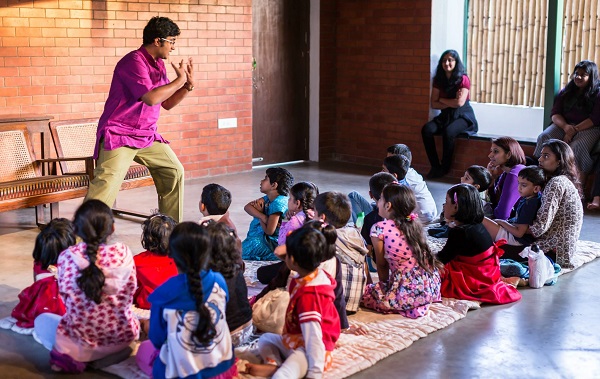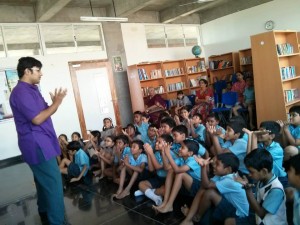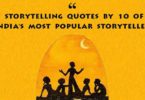Storytelling is an art form that is as old as human existence itself. In an age where parents resort to television, video and mobile to keep their kids engaged, Vikram Sridhar is a person dedicated to keeping the tradition of telling stories to a live audience, alive.
Vikram Sridhar is the brains behind Around The Story Tree, an initiative connecting children and adults to the natural world using Storytelling as a strong medium of conservation. He has previously acted and also worked with various companies. He is the main point of contact for marketing and publicity at Tahatto, a theater entity based out of Bangalore.
We spoke to Vikram about Around The Story Tree, the art of Storytelling and his love for Storytelling.
How would you identify yourself?
Toughest question! I would say I am a person who loves doing things in the simplest form. Interests vary from Ethology to Folklore to Social work. I keep constantly trying to feed these interests by exploring new avenues and opportunities.
When did you decide to turn a storyteller?
While I had always been a Theater Practitioner, I did not know the power of the medium and its practice in India. I had always used Stories while working with children and conservation during my volunteering days. During an official trip to Atlanta we had a workshop on Storytelling. In the course there were a lot of references to India and our folklore. On returning I was invited to share a story by Bookalore from the perspective of a theater person. And once the session was over I know I had connected my dots using 3 areas which I had always worked in. But I also knew that there were lots of stereotypes in stories and storytelling where, as a performer, I could challenge myself and challenge the current form of storytelling.
I started. And then work rolled in, where I had to take the art form to different spaces. That was a turning point and then I became a Storyteller in the professional term. After this I’ve heard my school and college friends refer that I always used to explain things to them in the form of a story. Wow! Wish we all knew things much in advance!
What propelled you to start Around the Story Tree?
After the first few months of conducting Storytelling sessions independently, there was a need to document my work. There were requests to share my work. And an online format works best in such times to instantaneously refer people to the body of work. And post a session at Atta Galatta under the same name, a friend suggested that I float the initiative under this name. And thus came about Around the Story Tree.
Do you believe storytelling is a dying art?
Indigenous art of any form can never die. They have to be adapted and modified in a contemporary form. Any performing arts would not have been the same 100 years back. Similarly, storytelling also has to be explored in a contemporary form to the new age audience. Storytelling itself is a broad term and we have innumerable ways to keep this wonderful form going. At a time when we are moving towards a gadget-driven world, a strong need to use forms like Storytelling that uses Human interactions is finding a lot of relevance.
What is your favorite audience and why?
There is no one such section. It’s that connect during a performance that makes the overall experience wonderful. I’ve had sessions with teachers, children, and community workers, all of who have responded brilliantly. Every time I keep finding that connect without creating a favorite audience.
You have conducted various sessions for all audience types. What type of stories, do you find, appeal the most to kids, and to grown-ups?
With children it’s definitely stories filled with animals, where there is scope for a lot of visualizations. With adults it’s those which touch an emotional chord. And a same folktale can be told to both groups but it needs to be adapted and interpreted differently. For example The Hare and the Tortoise from Aesop Fable can be just told as a simple story of 2 animals for children. While it has to be interpreted to the context of life and our journey, the bigger picture presented in the story, while sharing it with adults. As I always say, no folktale was ever written for children. As storytellers we have to identify the purpose constantly.
Is there any particular incident/anecdote from your sessions that you would like to share with readers?
This happened in Chennai while I was sharing a story with a section of students from class 5. The class was an inclusive one where differently challenged children were also present. Post the 1 hour session, the children came and hugged me. And one child with autism was sitting in a corner. While I was leaving the children told me that the autistic child wanted to touch me. I obliged and went. The child hugged my leg as she couldn’t stand up. The teacher interpreted that the child enjoyed the class. It was uncommon for the child to feel so with a new facilitator. It just proved that if we are genuine, the audience will connect with us.
Any suggestions to our readers on how they can help in keeping the tradition of storytelling alive?
Stories are present all the time, all around us, in the Indian tradition – the food we eat from the banana leaf, clothes we wear for functions, in the music we hear, the area we stay. We should keep reviving these and share with people around us. We sometimes know how pizza was invented but not where our idlis and rotis came from. A great way to revive stories is to look at our history, our folklore and share it with people. If we can use social media as a medium and not just as a gossip corner, the tradition of storytelling can never die out.
—
Don’t Miss: We love storytellers as much as we love storytelling. On Tell-a-Tale, we’ve featured a lot of talented storytellers, in the past.
Are you a Storyteller? If you’re a storyteller who is actively pursuing storytelling and would like to be featured in this column, drop us a mail at contact AT tell-a-tale.com or reach out to us via Facebook.







Hi,
I want to get in touch with Vikram for an session for our employees.
Priyanka
-9930455243
Hi i want to learn story telling online since i am stationed in mumbai